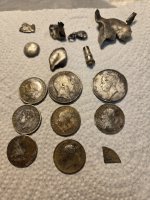EDDE
Gold Member
- Dec 7, 2004
- 7,129
- 65
- Detector(s) used
- Troy X5
- Primary Interest:
- All Treasure Hunting
Before making a comparison between the lead balls listed in the archaeological investigation and the guns to which they may have been matched, one must be acquainted with the term “windage.” Properly defined, “windage” is the difference between the diameter of the ball and the diameter of the bore of the gun being fired, or the small space between the ball and the inside of the barrel. There is a common misconception among seasoned historical reenactors and even some professional historians that a .69 cal smoothbore U. S. musket fired a .69 cal. lead ball. In fact, Harold L. Peterson has written that a .69 cal musket would have fired a ball closer to .63 caliber, while the larger .75 caliber British “Brown Bess” would have fired a .69 cal. ball. Mansberger and Stratton, note 20, correctly observed that “the smoothbore muskets in use during this period would have allowed a much wider tolerances in ball size (windage) than contemporary rifles arms (rifles).” Indeed, such tolerances would have varied more or less than the 0.04 standard generally applied by these investigators.
Another reality of the 1830s American military experience was the Army’s reliance on so-called “buck and ball” cartridge ammunition. Simply described, “buck and ball” consisted of one .63 cal. round ball and three .31 cal. buckshot, rolled into a cartridge with approximately 100 grains of gunpowder (per original cartridges and x-ray examination of original cartridges as illustrated in Berekely R. Lewis, “Small Arms and Ammunition in the United States Service,” Publication 4254, Smithsonian Institution.) Dating from its adoption in an order issued by General George Washington on October 6, 1777 prior to the battle of Germantown, “buck and ball” evolved as the standard American Army cartridge for its smoothbore military muskets throughout the War of 1812 and into the Black Hawk War. In fact, “buck and ball” was unique to the American military system, as the armies of Britain and France did not as a rule employ this style of ammunition.
Another reality of the 1830s American military experience was the Army’s reliance on so-called “buck and ball” cartridge ammunition. Simply described, “buck and ball” consisted of one .63 cal. round ball and three .31 cal. buckshot, rolled into a cartridge with approximately 100 grains of gunpowder (per original cartridges and x-ray examination of original cartridges as illustrated in Berekely R. Lewis, “Small Arms and Ammunition in the United States Service,” Publication 4254, Smithsonian Institution.) Dating from its adoption in an order issued by General George Washington on October 6, 1777 prior to the battle of Germantown, “buck and ball” evolved as the standard American Army cartridge for its smoothbore military muskets throughout the War of 1812 and into the Black Hawk War. In fact, “buck and ball” was unique to the American military system, as the armies of Britain and France did not as a rule employ this style of ammunition.




